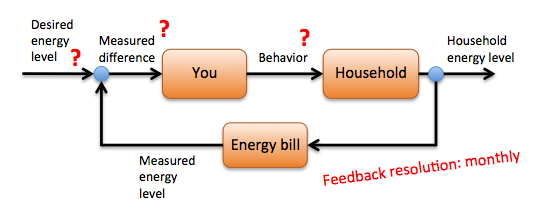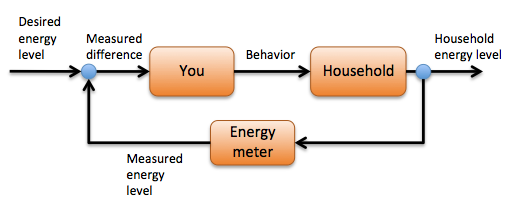In this blog post I try to put household energy usage in a control theory context to see if we can find better ways to influence behavior.
A lot of people are thinking about how we can reduce household energy use these days. Changing household energy use can be a challenge because to most people there is no working feedback loop available. Energy use is invisible. My own feedback loop consists of getting a monthly invoice displaying the cost I had for the previous month (e.g. “278 SEK”). That is a lousy feedback loop if you want to change behavior. I can not even see how much energy I used. Not that it matters because that information is useless without knowing what would be a reasonable level to compare with. And getting the information once a month does not provide a feedback loop for me to see the effect of my immediate behavior.
A basic model of a feedback loop for a system looks like this:

Based on a desired state (a reference value) a controller operates on a system and adjust control behavior based on the output from a sensor to make the system align the output to the desired state. For this to work there are a couple of things required:
- We must know what the desired state is. Without it we don’t know if the output from the system is good or bad.
- We must know the system output. Without the output we can’t calculate the measured error between output and the desired state.
- The controller must be able to provide system input to control the system and its parts in a predictable way.
- The delay between the actions of the controller and the sensor feedback needs to be short so that the result of different actions are visible.
Applying this basic model to the typical feedback loop for household energy use we get:

The “system” in this model would be your household. It consists of several things that use energy (refrigerator, TV, other appliances…). You control it by operating various appliances, setting the refrigerator temperature and making purchasing decisions for new hardware that affects energy use. You get the energy bill once a month with the amount of energy used.
As you can see there are several problems. I don’t know the desired energy level. Is my household below or above the average for similar households? If I switch off the TV instead of keeping it on standby, would it matter? Will setting a higher temperature in the refrigerator impact my energy use? Since I can’t see the immediate effects of my behavior there are no drivers to change it.
Real-time feedback and knowledge about the desired state
A first step to influence behavior would be to provide real-time feedback and information about a desired state. That would make it possible for you to try various control actions and see what implications they have on the system. There are a lot of third party solutions to get real-time feedback e.g. Wattson, TED-5000 and so on, but from what I have seen there are very few options to get information about a desired state. Getting more data about desired state can in part be accomplished by sharing information about your household and its energy use with others.

But, to be able to really affect behavior we need to increase the resolution of the parts of the system (at least sections or types of energy use in the household) by using multiple sensors and comparing the output with multiple desired states. This may quickly become complicated for an individual and a reasonable next step is to automate the controller function (you) by allowing automated control actions on parts of the system (e.g. adjusting your refrigerator temperature based on data about its contents, model, and similar household data).
I guess we have some work to do before we can get a better feedback loop in place. What’s in it for the energy companies? Will we have to install our own real-time meters?
(Thank you to Daniel Brolund who provided interesting insights into control theory last week).